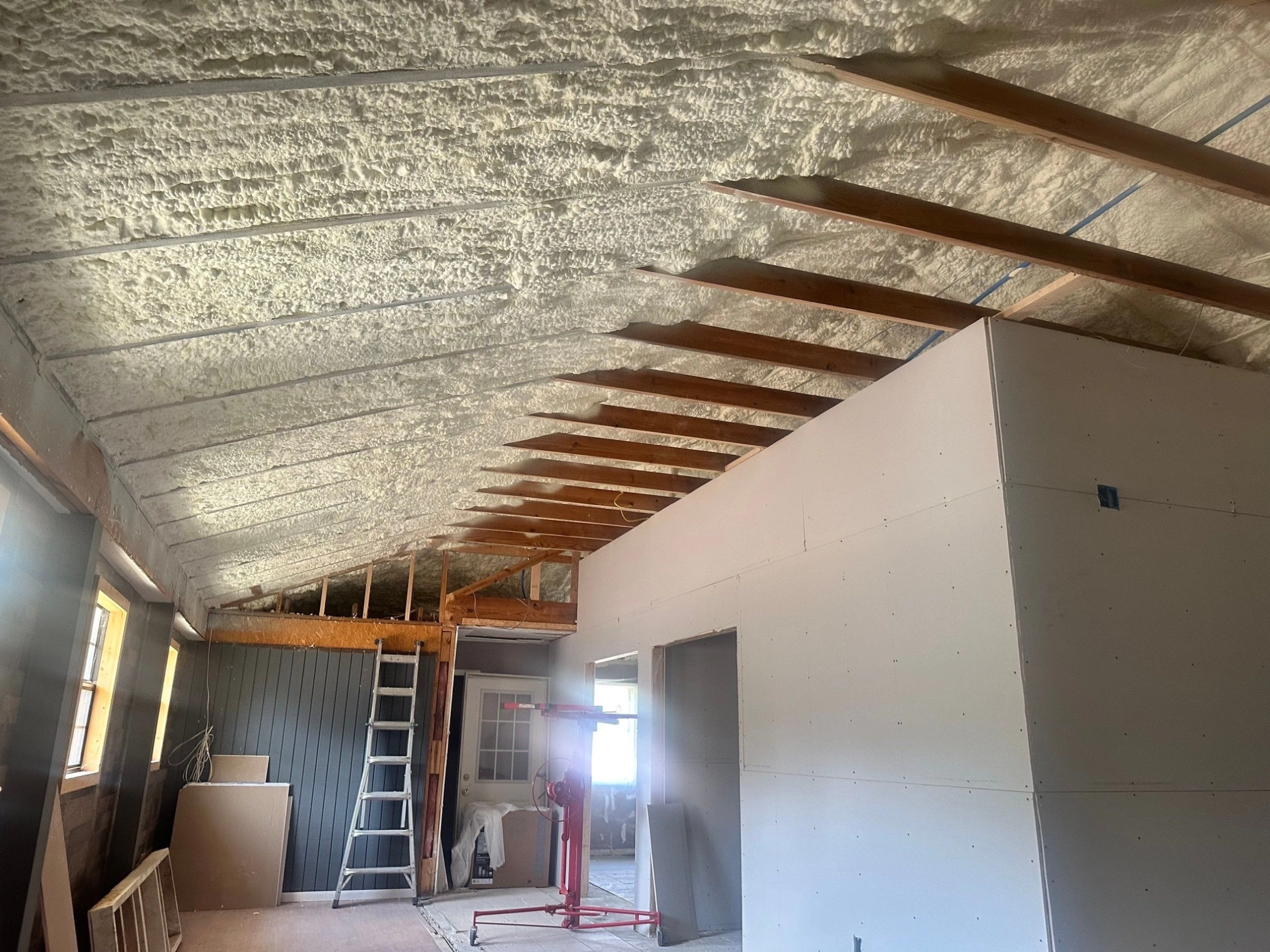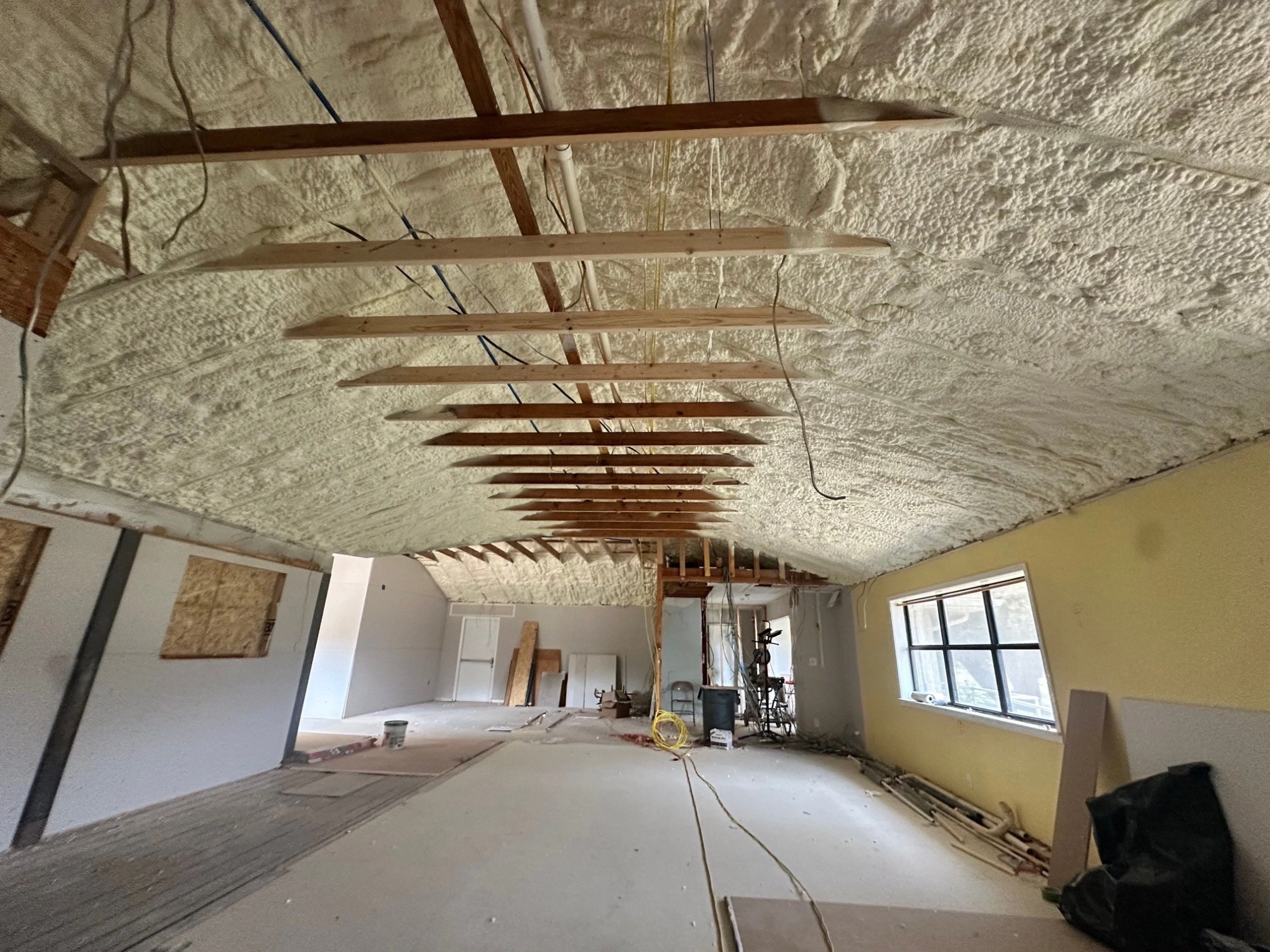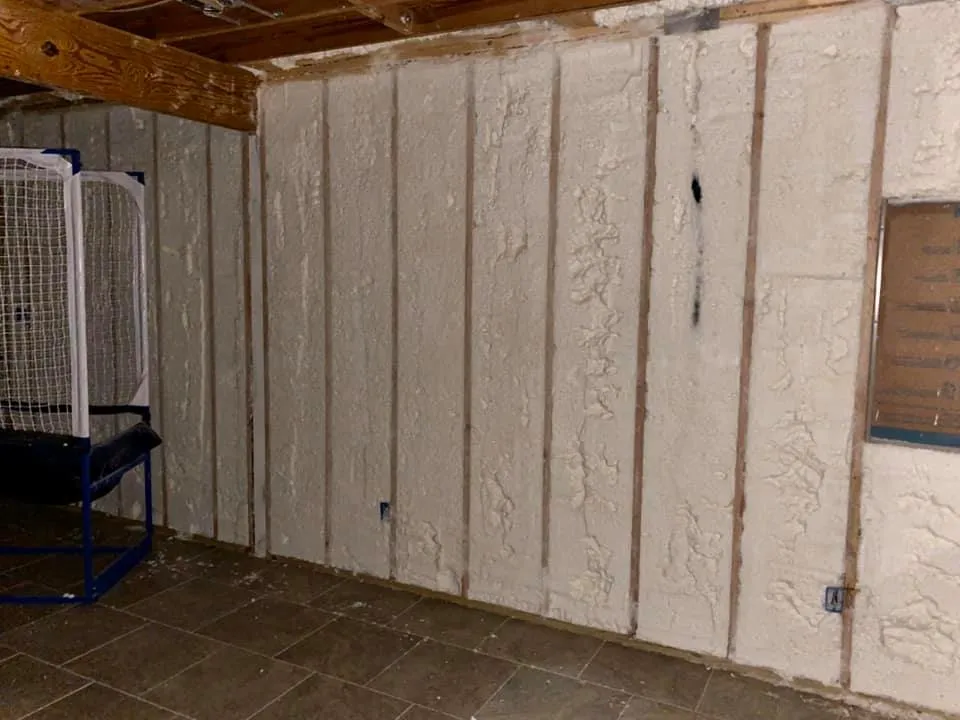Spray foam insulation dramatically enhances HVAC performance in Bastrop County properties by creating an airtight thermal barrier that reduces energy loss by 30-50% compared to traditional insulation methods. This advanced insulation technology eliminates air infiltration gaps, maintains consistent indoor temperatures, and allows HVAC systems to operate more efficiently while reducing utility costs throughout the region’s challenging climate conditions.
The combination of Bastrop County’s hot, humid summers and variable winter temperatures creates unique demands on residential and commercial HVAC systems. Spray foam insulation addresses these challenges by providing superior air sealing capabilities that traditional fiberglass and cellulose materials cannot match. Based on extensive field experience with Central Texas properties, properly installed spray foam systems consistently deliver measurable improvements in HVAC efficiency, indoor air quality, and long-term energy savings.
Understanding Spray Foam’s Impact on HVAC Efficiency
Spray foam insulation fundamentally transforms how HVAC systems perform by eliminating the primary cause of energy waste: uncontrolled air movement. Traditional insulation materials create gaps and thermal bridges that force HVAC equipment to work harder maintaining desired temperatures. Spray foam expands to fill every cavity, crack, and penetration, creating a continuous insulation envelope that maintains consistent indoor conditions.
The thermal resistance properties of spray foam significantly reduce heat transfer through building surfaces. Closed-cell spray foam provides R-values between 6-7 per inch, while open-cell foam delivers R-3.5 per inch. More importantly, spray foam maintains these thermal properties over time without settling, compressing, or degrading like conventional insulation materials.
Air sealing represents the most critical factor in HVAC performance improvement. Studies conducted by the Department of Energy demonstrate that air leakage accounts for 25-40% of heating and cooling costs in typical buildings. Spray foam creates an air barrier that reduces infiltration rates by 75-90% compared to traditional insulation approaches.
Climate-Specific Benefits for Bastrop County Properties
Bastrop County’s subtropical climate presents specific challenges that spray foam insulation effectively addresses. Summer temperatures frequently exceed 95°F with humidity levels above 70%, creating conditions where HVAC systems must remove both sensible and latent heat loads. Spray foam’s moisture resistance prevents condensation issues that commonly plague traditional insulation in high-humidity environments.
The region’s temperature swings between seasons require HVAC systems to handle both cooling and heating demands efficiently. Spray foam’s consistent thermal performance eliminates the hot and cold spots that force systems to cycle frequently, reducing equipment wear and maintaining more stable indoor conditions throughout seasonal transitions.
Performance Comparison of Insulation Types
| Insulation Type | R-Value per Inch | Air Sealing | Moisture Resistance | HVAC Load Reduction | Lifespan |
|---|---|---|---|---|---|
| Closed-Cell Spray Foam | 6.0-7.0 | Excellent | Vapor barrier | 30-50% | 50+ years |
| Open-Cell Spray Foam | 3.5-4.0 | Excellent | Good | 25-40% | 30+ years |
| Fiberglass Batts | 3.2-3.8 | Poor | Poor | 10-20% | 15-25 years |
| Cellulose | 3.6-3.8 | Fair | Poor | 15-25% | 20-30 years |
| Rigid Foam Boards | 4.0-6.5 | Fair | Good | 20-35% | 25-40 years |
Technical Specifications for HVAC Performance Enhancement
| Performance Metric | Open-Cell Foam | Closed-Cell Foam | Industry Standard |
|---|---|---|---|
| Air Infiltration Reduction | 75-85% | 85-95% | 50-70% |
| Thermal Bridging Elimination | 90% | 95% | 60% |
| Humidity Control | Moderate | Excellent | Poor |
| HVAC Runtime Reduction | 25-35% | 35-45% | 15-25% |
| Energy Cost Savings | 20-30% | 30-50% | 10-20% |
According to the National Association of Home Builders, properly installed spray foam insulation reduces HVAC equipment sizing requirements by 20-30% in new construction applications. This allows property owners to install smaller, more efficient HVAC systems that maintain superior comfort levels while consuming less energy.
Key Factors Affecting HVAC Performance Improvement
Installation quality directly impacts spray foam’s effectiveness in supporting HVAC performance. Proper surface preparation, correct mixing ratios, and appropriate application thickness ensure optimal thermal and air sealing properties. Inadequate installation can create thermal bridges and air leakage paths that compromise system efficiency.
Building envelope design influences how effectively spray foam enhances HVAC performance. Properties with complex geometries, multiple penetrations, or unusual architectural features require careful planning to achieve complete air sealing. Spray foam’s ability to conform to irregular surfaces makes it ideal for challenging applications where other insulation types fail.
HVAC system compatibility must be considered when installing spray foam insulation. Improved building envelope performance may require HVAC system adjustments, including revised control strategies, modified airflow patterns, and updated ventilation requirements to maintain proper indoor air quality.
Bonus Tip: Schedule spray foam installation during moderate weather conditions when temperatures remain between 60-80°F. This temperature range allows optimal foam expansion and curing, ensuring maximum adhesion and thermal performance that directly translates to improved HVAC efficiency.
Things to Consider Before Making a Decision
Property age significantly influences spray foam installation approaches and expected HVAC performance improvements. Older buildings typically experience greater benefits due to existing air leakage issues, while newer construction may require careful evaluation of existing insulation performance before determining optimal spray foam applications.
HVAC system age and efficiency ratings affect the cost-benefit analysis of spray foam installation. Properties with older, less efficient HVAC equipment may experience dramatic performance improvements, while those with newer high-efficiency systems will still benefit but may see more modest percentage improvements.
Budget considerations should account for both material costs and long-term energy savings when evaluating spray foam options. While initial investment exceeds traditional insulation costs, the combination of HVAC efficiency improvements and extended equipment lifespan typically provides positive returns within 3-5 years.
Local building codes and permit requirements may influence spray foam installation specifications. Bastrop County follows Texas state building codes that include specific requirements for insulation R-values and air sealing performance in different climate zones.
Bonus Tip: Consider whole-house energy audits before and after spray foam installation to quantify actual HVAC performance improvements. Professional energy assessments provide documented evidence of efficiency gains and help optimize HVAC system settings for maximum benefit.

Professional Spray Foam Services for Enhanced HVAC Performance
Stellrr Insulation & Spray Foam provides specialized spray foam applications designed to maximize HVAC efficiency in Bastrop County properties. Each installation focuses on creating comprehensive air sealing solutions that deliver measurable performance improvements.
- Closed-Cell Spray Foam Installation: Premium insulation solution providing maximum thermal resistance and vapor barrier properties for optimal HVAC efficiency. Ideal for challenging applications requiring superior moisture control and structural reinforcement.
- Open-Cell Spray Foam Application: Cost-effective option delivering excellent air sealing performance with sound dampening benefits. Suitable for interior applications where vapor barriers are not required but air infiltration control remains critical.
- Attic Spray Foam Systems: Specialized applications targeting the most significant source of energy loss in most buildings. Creates conditioned attic spaces that reduce HVAC ductwork losses and improve overall system efficiency.
- Commercial HVAC Support Solutions: Large-scale spray foam installations designed for commercial properties with complex HVAC requirements. Focuses on reducing operational costs while maintaining consistent comfort conditions throughout building spaces.
Bonus Tip: Schedule spray foam installation during HVAC system maintenance periods to coordinate any necessary adjustments and ensure optimal integration between improved building envelope performance and mechanical system operation.
Measuring and Maintaining HVAC Performance Benefits
Regular monitoring of HVAC performance indicators helps property owners track the ongoing benefits of spray foam insulation. Key metrics include monthly energy consumption, system runtime hours, indoor temperature stability, and humidity control effectiveness. These measurements provide quantifiable evidence of improved efficiency and help identify any maintenance needs.
Professional HVAC maintenance becomes even more important after spray foam installation because systems operate in more controlled environments. Improved air quality and reduced infiltration mean filters may last longer, but regular inspection ensures optimal performance as systems adapt to enhanced building envelope conditions.
Long-term performance tracking reveals the cumulative benefits of spray foam installation on HVAC efficiency. Properties typically experience continued improvements as systems adapt to more stable operating conditions, and equipment lifespan often extends beyond manufacturer specifications due to reduced cycling and more consistent operating environments.
Common Questions About Spray Foam and HVAC Performance
How quickly will spray foam installation improve HVAC efficiency?
Most properties experience immediate improvements in temperature stability and comfort levels within 24-48 hours after installation. Measurable energy savings typically become apparent in the first monthly utility bill following completion.
Does spray foam require HVAC system modifications?
Most existing HVAC systems operate more efficiently without modifications after spray foam installation. However, properties with dramatically improved envelope performance may benefit from professional system evaluation to optimize airflow and control settings.
Can spray foam installation damage existing HVAC ductwork?
Proper spray foam installation protects and insulates existing ductwork when applied correctly. Professional installers take precautions to avoid overspray on sensitive HVAC components and ensure adequate clearances around equipment.
Will spray foam affect indoor air quality with existing HVAC systems?
Spray foam improves indoor air quality by reducing uncontrolled air infiltration that brings in outdoor pollutants, allergens, and humidity. Properly functioning HVAC ventilation systems continue operating normally while managing cleaner, more controlled indoor environments.
Key Takeaways for HVAC Performance Enhancement
Spray foam insulation delivers measurable HVAC performance improvements through superior air sealing and thermal resistance properties that traditional insulation materials cannot match. The combination of reduced air infiltration and consistent thermal performance allows HVAC systems to operate more efficiently while maintaining superior comfort conditions year-round.
Property owners in Bastrop County benefit from spray foam’s ability to address the specific challenges of Central Texas climate conditions. The moisture resistance and thermal stability of spray foam insulation create optimal conditions for HVAC efficiency while protecting equipment from humidity-related issues common in the region.
Professional installation remains critical for achieving maximum HVAC performance benefits from spray foam applications. Proper surface preparation, correct application techniques, and comprehensive air sealing ensure optimal results that deliver long-term energy savings and improved comfort conditions.
Get Expert Insulation Guidance
Transform your property’s HVAC performance with professional spray foam insulation solutions designed specifically for Bastrop County’s climate challenges. Expert installation ensures maximum efficiency improvements and long-term energy savings that justify the investment through reduced utility costs and enhanced comfort.
Contact Stellrr Insulation & Spray Foam for detailed consultation and customized spray foam solutions that deliver measurable HVAC performance improvements. Professional assessment identifies optimal applications for your specific property requirements and existing HVAC system configuration.
Stellrr Insulation & Spray Foam
Phone: (512) 710-2839
Email: info@stellrr.com
Schedule comprehensive property evaluation to determine the most effective spray foam applications for enhancing HVAC efficiency and reducing long-term operating costs in your Bastrop County property.
Frequently Asked Questions
What HVAC efficiency improvements can I expect from spray foam insulation in Bastrop County?
Most properties experience 25-50% reductions in HVAC energy consumption depending on existing insulation conditions and system efficiency. Closed-cell applications typically deliver higher performance improvements, while open-cell foam provides excellent results at lower initial costs.
How does spray foam compare to other insulation types for HVAC performance?
Spray foam consistently outperforms traditional insulation materials due to its superior air sealing capabilities. While fiberglass and cellulose provide thermal resistance, only spray foam eliminates air infiltration that accounts for the majority of HVAC energy waste in most buildings.
Will spray foam insulation require changes to my existing HVAC system?
Most HVAC systems operate more efficiently without modifications after spray foam installation. However, properties with significant envelope improvements may benefit from professional evaluation to optimize system settings and ensure adequate ventilation for improved indoor air quality.
How long does spray foam maintain its HVAC performance benefits?
Quality spray foam installations maintain their thermal and air sealing properties for decades. Closed-cell foam typically provides 50+ years of consistent performance, while open-cell applications deliver reliable benefits for 30+ years with minimal degradation.
Can spray foam installation help reduce HVAC maintenance costs?
Yes, spray foam reduces HVAC maintenance requirements by creating cleaner operating environments with less dust infiltration and more stable operating conditions. Systems experience less wear from frequent cycling, and filters typically require less frequent replacement due to reduced air infiltration.





